Best Way To Deal With An Angry Customer

Ever felt your blood pressure rise while dealing with a disgruntled customer? You're not alone. Mastering the art of diffusing anger is crucial for any business, especially those just starting out.
This guide aims to equip first-time business owners with practical strategies to navigate challenging customer interactions and turn potential disasters into opportunities for loyalty.
Why is this important? Because a single negative experience can spread like wildfire in today's connected world, impacting your reputation and bottom line.
Understanding the Angry Customer
Before diving into solutions, let's understand the root of customer anger. It's rarely about you personally.
Often, it stems from unmet expectations, frustration with a product or service, or a feeling of being ignored.
They simply want to be heard and understood.
Top 5 Strategies for Handling Angry Customers
Here's a comparison of five effective approaches:
| Strategy | Description | Pros | Cons |
|---|---|---|---|
| Active Listening | Focusing intently on what the customer is saying, both verbally and nonverbally. | Builds rapport, identifies the core issue. | Can be time-consuming if the customer is rambling. |
| Empathy | Acknowledging the customer's feelings and showing that you understand their frustration. | De-escalates the situation, fosters trust. | Requires genuine understanding and can be challenging with abusive customers. |
| Apology | Expressing regret for the customer's negative experience, even if you're not directly at fault. | Reduces tension, shows accountability. | Must be sincere and not sound like a generic statement. |
| Solution-Oriented Approach | Focusing on finding a resolution to the customer's problem as quickly as possible. | Demonstrates commitment to customer satisfaction, resolves the issue efficiently. | May require immediate decision-making and resources. |
| Setting Boundaries | Politely but firmly establishing limits on unacceptable behavior (e.g., abusive language). | Protects employees, maintains professionalism. | Requires strong communication skills and can potentially escalate the situation if not handled carefully. |
Detailed Reviews of Each Strategy
Active Listening: Hear Them Out
Active listening isn't just about hearing the words; it's about truly understanding the message. Pay attention to their tone, body language, and the specific details of their complaint.
Rephrasing their concerns in your own words ("So, if I understand correctly, you're saying...") shows you're engaged and helps clarify the issue.
Avoid interrupting or offering solutions prematurely. Let them vent completely.
Empathy: Put Yourself in Their Shoes
Empathy is the cornerstone of effective customer service. Acknowledge their feelings with statements like, "I understand how frustrating that must be."
Even if you don't agree with their assessment, validating their emotions can significantly de-escalate the situation. Saying "I can see why you're upset" goes a long way.
Remember, it's about understanding their perspective, not necessarily agreeing with it.
Apology: Take Responsibility
A sincere apology can diffuse anger quickly. Avoid making excuses or blaming others.
Even if the issue wasn't your fault, apologize for the inconvenience or negative experience. A simple "I'm sorry you had this experience" can be powerful.
Ensure your apology is genuine and reflects a desire to make things right.
Solution-Oriented Approach: Focus on Resolution
Once you understand the problem, shift your focus to finding a solution. Ask the customer what would make them happy.
Offer a range of options, if possible, and be prepared to go the extra mile to resolve the issue. This could include a refund, a replacement, or a discount on future purchases.
Clearly communicate the steps you'll take and the timeline for resolution.
Setting Boundaries: Maintain Professionalism
While empathy and understanding are crucial, it's also important to set boundaries. Abusive language or threats are never acceptable.
Politely but firmly state that you cannot assist them if they continue to be disrespectful. You might say, "I want to help, but I can't continue this conversation if you're using that kind of language."
Document the interaction and, if necessary, escalate the situation to a supervisor or security.
"Used vs. New" Approach: Adapting to Different Situations
Just like a product can be new or used, these strategies can be applied in different contexts. Sometimes a "new" (direct and immediate) solution is needed.
Other times, a "used" (more nuanced and patient) approach is more effective. Knowing when to apply each strategy is key.
A new, direct approach would be used when someone is being verbally abusive. A more used approach would be active listening.
- New (Direct): Ideal for situations requiring immediate action, like setting boundaries or addressing a clear mistake. Focuses on efficiency and immediate resolution.
- Used (Nuanced): Best for complex issues where understanding and empathy are paramount. Requires patience and a willingness to explore the customer's perspective.
Reliability Ratings by Strategy (Effectiveness)
Not all strategies are created equal. Some are more consistently effective than others.
Here's a subjective rating based on overall reliability:
- Active Listening: 5/5 (Consistently effective in gathering information and building rapport)
- Empathy: 4/5 (Highly effective for de-escalation, but requires genuine understanding)
- Apology: 4/5 (Powerful, but only effective if sincere)
- Solution-Oriented Approach: 3/5 (Effective if a viable solution exists; can be frustrating if not)
- Setting Boundaries: 5/5 (Essential for protecting employees, but requires careful execution)
Checklist: 5 Must-Check Aspects Before Reacting
Before reacting, make sure you've considered these five crucial aspects:
- The root cause of the anger: Is it a product defect, a service failure, or something else entirely?
- The customer's desired outcome: What do they want to achieve by complaining?
- Your company's policies: Are there established procedures for handling this type of complaint?
- Your available resources: What solutions can you realistically offer?
- Your emotional state: Are you calm and composed, or are you feeling defensive?
Key Takeaways
Handling angry customers is a skill that can be learned and improved. Active listening, empathy, and a solution-oriented approach are crucial for de-escalating situations and building customer loyalty.
Remember to set boundaries and prioritize the well-being of your employees. Each strategy has its own time and place, use them accordingly.
Ultimately, turning a negative experience into a positive one can be a powerful way to build trust and strengthen your brand.
Call to Action
Ready to put these strategies into practice? Start by actively listening to your customers' feedback and identifying areas for improvement.
Consider role-playing scenarios with your team to prepare for challenging interactions. This will help foster empathy, and learn the appropriate approach.
Download our free guide on "Building a Customer-Centric Culture" to further enhance your customer service skills. And, remember, every interaction is an opportunity to build a lasting relationship with your customers.









![Best Way To Deal With An Angry Customer How to Deal with an Angry Customer [Infographic] - Nationwide Inbound Inc.](https://www.nationwideinbound.com/wp-content/uploads/2022/06/How-To-Deal-with-Angry-Customer-06-1080x675.jpg)





![Best Way To Deal With An Angry Customer How to Handle Angry Customers [Infographic] | PDF](https://cdn.slidesharecdn.com/ss_thumbnails/howtohandleangrycustomers-140529112300-phpapp01-thumbnail.jpg?width=640&height=640&fit=bounds)


